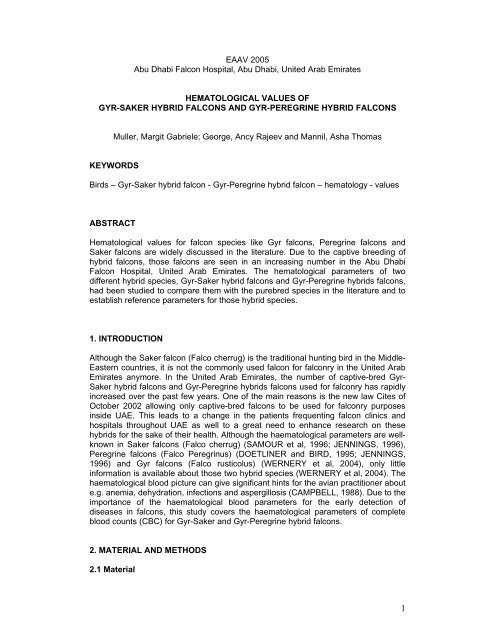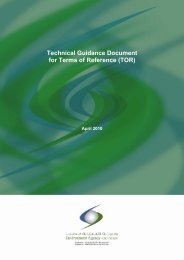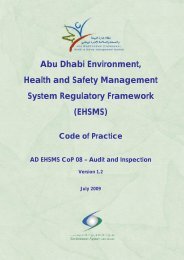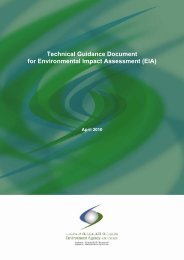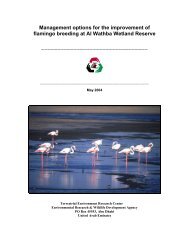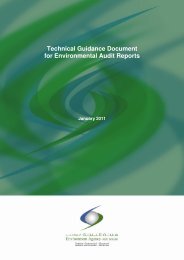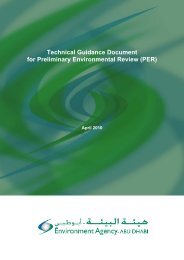hematological values of gyr-saker hybrid falcons and
hematological values of gyr-saker hybrid falcons and
hematological values of gyr-saker hybrid falcons and
- No tags were found...
Create successful ePaper yourself
Turn your PDF publications into a flip-book with our unique Google optimized e-Paper software.
EAAV 2005Abu Dhabi Falcon Hospital, Abu Dhabi, United Arab EmiratesHEMATOLOGICAL VALUES OFGYR-SAKER HYBRID FALCONS AND GYR-PEREGRINE HYBRID FALCONSMuller, Margit Gabriele; George, Ancy Rajeev <strong>and</strong> Mannil, Asha ThomasKEYWORDSBirds – Gyr-Saker <strong>hybrid</strong> falcon - Gyr-Peregrine <strong>hybrid</strong> falcon – hematology - <strong>values</strong>ABSTRACTHematological <strong>values</strong> for falcon species like Gyr <strong>falcons</strong>, Peregrine <strong>falcons</strong> <strong>and</strong>Saker <strong>falcons</strong> are widely discussed in the literature. Due to the captive breeding <strong>of</strong><strong>hybrid</strong> <strong>falcons</strong>, those <strong>falcons</strong> are seen in an increasing number in the Abu DhabiFalcon Hospital, United Arab Emirates. The <strong>hematological</strong> parameters <strong>of</strong> twodifferent <strong>hybrid</strong> species, Gyr-Saker <strong>hybrid</strong> <strong>falcons</strong> <strong>and</strong> Gyr-Peregrine <strong>hybrid</strong>s <strong>falcons</strong>,had been studied to compare them with the purebred species in the literature <strong>and</strong> toestablish reference parameters for those <strong>hybrid</strong> species.1. INTRODUCTIONAlthough the Saker falcon (Falco cherrug) is the traditional hunting bird in the Middle-Eastern countries, it is not the commonly used falcon for falconry in the United ArabEmirates anymore. In the United Arab Emirates, the number <strong>of</strong> captive-bred Gyr-Saker <strong>hybrid</strong> <strong>falcons</strong> <strong>and</strong> Gyr-Peregrine <strong>hybrid</strong>s <strong>falcons</strong> used for falconry has rapidlyincreased over the past few years. One <strong>of</strong> the main reasons is the new law Cites <strong>of</strong>October 2002 allowing only captive-bred <strong>falcons</strong> to be used for falconry purposesinside UAE. This leads to a change in the patients frequenting falcon clinics <strong>and</strong>hospitals throughout UAE as well to a great need to enhance research on these<strong>hybrid</strong>s for the sake <strong>of</strong> their health. Although the haematological parameters are wellknownin Saker <strong>falcons</strong> (Falco cherrug) (SAMOUR et al, 1996; JENNINGS, 1996),Peregrine <strong>falcons</strong> (Falco Peregrinus) (DOETLINER <strong>and</strong> BIRD, 1995; JENNINGS,1996) <strong>and</strong> Gyr <strong>falcons</strong> (Falco rusticolus) (WERNERY et al, 2004), only littleinformation is available about those two <strong>hybrid</strong> species (WERNERY et al, 2004). Thehaematological blood picture can give significant hints for the avian practitioner aboute.g. anemia, dehydration, infections <strong>and</strong> aspergillosis (CAMPBELL, 1988). Due to theimportance <strong>of</strong> the haematological blood parameters for the early detection <strong>of</strong>diseases in <strong>falcons</strong>, this study covers the haematological parameters <strong>of</strong> completeblood counts (CBC) for Gyr-Saker <strong>and</strong> Gyr-Peregrine <strong>hybrid</strong> <strong>falcons</strong>.2. MATERIAL AND METHODS2.1 Material1
The <strong>hematological</strong> parameters <strong>of</strong> 689 clinically healthy <strong>hybrid</strong> <strong>falcons</strong> wereevaluated. All <strong>falcons</strong> that were showing clinical signs or that were diagnosed withdisease were excluded from in this study. The complete blood count (CBC) <strong>of</strong> 369Gyr-Saker <strong>hybrid</strong> <strong>falcons</strong> <strong>and</strong> 320 Gyr-Peregrine <strong>hybrid</strong> <strong>falcons</strong> has been examinedmanually. After taking blood from the right or left basilica vein (Vena cutanea ulnarissuperficialis) or the right or left caudal tibial vein (Vena metatarsalis plantarissuperficialis), 0.5ml blood was stored in a 1.0 ml EDTA tube (Teklab). The bloodcount was performed directly after blood taking with a maximum delay time <strong>of</strong> 30minutes.2.2 MethodRed blood cell count (RBC) (SAMOUR et al 1996)The working solution consists <strong>of</strong> 10 ml 40% formaldehyde, 31.3 g trisodium citrate<strong>and</strong> 1000 ml distilled water. 4 ml <strong>of</strong> this solution has been mixed in a plain sampletube with 20µl <strong>of</strong> the falcon blood stored in the EDTA tube. This diluted sample hasbeen filled via a capillary tube in the improved Neubauer haemocytometer. After 5minutes waiting time, the cells <strong>of</strong> 5x16 squares have been counted in the center <strong>of</strong>the counting grid. The counted cells had been calculated as follows:N=Number <strong>of</strong> cells counted, then: N = RBC x 10 12 / l100White blood cell count (WBC) (SAMOUR et al 1996)1.9 ml <strong>of</strong> a 1% ammonium oxalate solution had been mixed with 100 µl <strong>of</strong> the falconblood sample <strong>and</strong> kept on a tube roller for 3 minutes. A small amount <strong>of</strong> the dilutedsamples has been filled via a capillary tube in the improved Neubauerhaemocytometer. After 5 minutes waiting time, the cells <strong>of</strong> 4 outer large squareshave been counted in the center <strong>of</strong> the counting grid. The counted cells had beencalculated as follows:N=Number <strong>of</strong> cells counted, then: N = WBC x 10 9 / l20Packed cell volume (PCV)/ Haematocrit (Hct) (SAMOUR et al 1996)The PCV is measured by the used <strong>of</strong> microhaematocrit capillary tubes (Fortuna,Germany) <strong>and</strong> centrifuge (Hawsley, UK). In our study, the hematocrit is used as thismight be the more accurate than the PCV (FUDGE, 2000)Mean cell volume: PCV x 10 = MCV(fl)RBCMean cell haemoglobin: Hb x 10 = MCH (pg)RBCMean cell haemoglobin concentration: Hb x 100 = MCHC (g/l)PCVHemoglobinThe hemoglobin is measured by capillary, venous or arterial blood used in EDTA.The optical eye <strong>of</strong> the Hemocue Microcuvette contains reagents deposited on itsinner wall <strong>and</strong> the blood sample is drawn in to the cavity by capillary actionspontaneously mixed with the reagents. Used with the HemoCue photometer, thesystem provides a direct reading <strong>of</strong> the concentration <strong>of</strong> hemoglobin in a bloodsample.Preparation <strong>of</strong> blood smearTake one small drop <strong>of</strong> blood sample in a clean microscopic slide. Position aspreader slide in front <strong>of</strong> the drop <strong>of</strong> blood at an angle <strong>of</strong> about 45° <strong>and</strong> move the2
spreader backwards <strong>and</strong> touch gently the drop <strong>of</strong> blood which will run across theedge <strong>of</strong> the slide. Push the spreader with a steady forward movement to create ablood smear.Staining method. The HEMAstain test is for the rapid, differential staining <strong>of</strong><strong>hematological</strong> smears that yields qualitative results similar to Wright-Giemsa stain.The slide is dipped in fixative solution for 5 seconds, than in solution.1 for 5 seconds<strong>and</strong> than in solution 11 for 5 seconds. The excess solution is allowed to drain. Theslide is rinsed with distilled or deionized water, then allowed to dry <strong>and</strong> examinedunder oil immersion lens.The examination <strong>of</strong> the blood smear for the shape <strong>of</strong> the blood cells <strong>and</strong> avian bloodparasites is routinely performed for each blood smear, but is not part <strong>of</strong> this study.3. ResultsThe evaluation <strong>of</strong> the 369 Falco rusticolus x Falco cherrug <strong>hybrid</strong> <strong>falcons</strong> showed thefollowing picture:Table 1: Hematological parameters for Gyr-Saker <strong>hybrid</strong> <strong>falcons</strong> (Falco rusticolus xFalco cherrug)Parameters n=369 rangeRBC (x10 12 /l) 2.33±0.15 2.18-2.48HB (g/dl) 17.73±1.50 16.23-19.23Hct % 51.57±4.66 46.91-56.23MCV (fl) 221.85±21.64 200.29-243.49MCH (pg) 76.24±6.83 69.41-83.07MCHC (g/dl) 34.42±1.57 32.85-35.99WBC (x 10 9 /l) 7.50±2.22 5.28-9.72Heterophils % 49.90±3.88 46.02-53.78Lymphocytes % 44.11±2.91 41.20-47.02Monocytes % 4.42±1.58 2.84-6.00Eosinophils % 1.29±0.92 0.37-2.21Basophils % 0.40±0.15 0.25-0.55The 320 evaluated Falco rusticolus x Falco peregrinus led to those results:Table 2: Hematological parameters for Gyr-Peregrine <strong>hybrid</strong> <strong>falcons</strong> (Falco rusticolusx Falco peregrinus)Parameters n=320 rangeRBC (x10 12 /l) 2.39±0.26 2.13-2.65HB (g/dl) 17.9±1.57 16.33-19.47Hct % 52.00±4.75 47.25-56.75MCV (fl) 219.7±25.38 194.32-245.08MCH (pg) 75.59±8.45 67.14-84.04MCHC (g/dl) 34.43±1.48 32.95-35.91WBC (x 10 9 /l) 7.55±2.27 5.28-9.82Heterophils % 49.91±3.50 46.41-53.41Lymphocytes % 44.18±3.36 40.82-47.54Monocytes % 4.40±1.63 2.77-6.033
Eosinophils % 1.37±1.08 0.29-2.45Basophils % 0.14±0.014 0-04. DISCUSSIONExtensive work has been done on the <strong>hematological</strong> parameters <strong>of</strong> peregrine <strong>falcons</strong>(Falco peregrinus). Although the range <strong>of</strong> some parameters is relatively close,significant differences can be seen in MCV, WBC, heterophils, lymphocytes,monocytes <strong>and</strong> eosinophils.Table 3. Literature comparison <strong>of</strong> <strong>hematological</strong> parameters in peregrine <strong>falcons</strong>ParametersJENNINGS1996DOETLINGER<strong>and</strong> BIRD 1995WERNERYet al 2004n=70 n=48 n=138RBC (x10 12 /l) 2.95-3.94 3.49±0.21 3.18±0.50PCV % 37-53 ---- ----HB (g/dl) 11.80-18.80 14.82±1.32 14.67±2.06Hct l/l ----- 0.40±0.38 0.44±0.06MCV (fl) 188-146 117.51±7.70 138.43±6.60MCH (pg) 40.00-48.4 ----- 46.13±2.10MCHC (g/dl) 31.90-35.20 ----- ----WBC (x 10 9 /l) 3.30-11.00 12.56±3.06 9.32±4.69Heterophils % 14.00-85.50 45.20±12.00 60.95±12.01Lymphocytes % 11.00-33.00 55.20±13.60 32.00±11.81Monocytes% 1.00-8.60 2.50±0.30 6.32±3.65Eosinophils % 0-0.3 2.30±0.90 0.52Basophils % 0-0.6 ---- 0.26A similar picture shows the literature comparison <strong>of</strong> the hematology <strong>values</strong> <strong>of</strong> Saker<strong>falcons</strong> (Falco cherrug). Major differences can be found in MCV, MCH, WBC,heterophils, lymphocytes <strong>and</strong> monocytes.Table 4: Literature comparison <strong>of</strong> <strong>hematological</strong> parameters in Saker <strong>falcons</strong>JENNINGS1996SAMOUR,D'ALOIA 1996 WERNERY et al 2004Parameters n=50 n=25 n=146RBC (x10 12 /l) 2.54-3.96 2.64±0.08 3.18±0.29PCV % 38-49 ---- -----HB (g/dl) 11.50-16.50 15.93±0.38 15.00±1.46Hct l/l ---- 0.47±0.59 0.45±0.04MCV (fl) 124-147 183.16±3.84 141.50±5.89MCH (pg) 41.40-45.40 60.74±1.42 47.17±1.73MCHC (g/dl) 30.40-34.90 33.28±0.63 -----WBC (x 10 9 /l) 3.80-11.50 5.70±0.31 10.21±3.53Heterophils % 26.00-58.50 41.40±2.40 61.78±11.16Lymophocytes % 8.00-42.50 13.30±0.90 31.11±11.46Monocytes % 2.10±0.30 4.72±3.02Eosinophils % 0-2 0 1.12Basophils % 0-0.45 0.80±0.10 0.4Only little information is available on the Gyr <strong>falcons</strong> (Falco rusticolus).4
Table 5: Literature data <strong>of</strong> <strong>hematological</strong> parameters in Gyr <strong>falcons</strong> (Falco rusticolus)WERNERY et al 2004Parameters n=187RBC (x10 12 /l) 3.23±0.28HB (g/dl) 15.00±1.33Hct l/l 0.45±0.04MCV (fl) 139.32±5.44MCH (pg) 45.78±1.84WBC (x 10 9 /l) 8.71±3.80Heterophils % 58.53±12.90Lymphocytes % 37.54±12.98Monocytes % 3.72±2.50Eosinophils % 0.2Basophils % 0The value ranges <strong>of</strong> the Gyr peregrine <strong>hybrid</strong> <strong>falcons</strong> (Falco rusticolus x Falcoperegrinus) differ especially <strong>of</strong> RBC, MCV, WBC, heterophils <strong>and</strong> eosinophils (table6). RBCs in the range <strong>of</strong> 3.35 are very rarely evaluated among our patient clientele.As per our observation at the Abu Dhabi Falco Hospital, <strong>falcons</strong> with a WBC <strong>of</strong> 12.55<strong>and</strong> 70% heterophils, being the maximum range <strong>of</strong> WERNERY et al (2004), showalready clinical signs <strong>of</strong> reduced well-being like reduced appetite, not flying well <strong>and</strong>not gaining weight.Table 6: Comparison between <strong>hematological</strong> <strong>values</strong> in the literature <strong>and</strong> ourlaboratory results <strong>of</strong> Gyr-Peregrine <strong>hybrid</strong> <strong>falcons</strong> (Falco rusticolus x Falcoperegrinus)WERNERY et al Study resultsParameters n=267 n=320RBC (x10 12 /l) 3.35±0.12 2.39±0.26HB (g/dl) 15.33±0.62 17.9±1.57Hct % 46.00±2.0 52.00±4.75MCV (fl) 137.31±4.15 219.7±25.38MCH (pg) 45.70±3.43 75.59±8.45MCHC (g/dl) ---- 34.43±1.48WBC (x 10 9 /l) 9.31±3.24 7.55±2.27Heterophils % 60.00±10.00 49.91±3.50Lymphocytes % 37.43±11.18 44.18±3.36Monocytes % 2.57±1.23 4.40±1.63Eosinophils % 0 1.37±1.08Basophils % 0 0.14±0.014WERNERY et al (2004) evaluated the Gyr <strong>hybrid</strong> <strong>falcons</strong> by combining Gyr-Saker<strong>and</strong> Gyr-Peregrine <strong>hybrid</strong> <strong>falcons</strong>. The results <strong>of</strong> our study show that the<strong>hematological</strong> <strong>values</strong> <strong>of</strong> both <strong>hybrid</strong> species are relatively close to each other, yet farbelow the results measured in WERNERY et al (2004). From our patients records<strong>hybrid</strong> <strong>falcons</strong> with such elevated blood parameters <strong>of</strong>ten display infections oraspergillosis. The high <strong>values</strong> might be related to the use <strong>of</strong> the Cell Dyn 3500analyzer (Abbott Laboratory, North Chicago IL) used for the calculation <strong>of</strong> RBC, WBC<strong>and</strong> packed cell volume (WERNERY et al, 2004). When using the Cell Dyn 3500analyzer (Abbott Laboratory, North Chicago IL) we experienced that this equipmentcan process only a low number <strong>of</strong> daily falcon blood samples with accurate results.For the examination <strong>of</strong> more than approx. 10 samples per day, the Cell Dyn 3500analyzer is not able to run the falcon blood with its very thick consistency thus5
leading to unreliable results due to blockage <strong>of</strong> the washing function <strong>of</strong> the analyzer.This technical problem resulted in parameters showing very high <strong>values</strong> that werecontradicting clinical conditions <strong>of</strong> the <strong>falcons</strong>. Due to these unreliable results, theAbu Dhabi Falcon Hospital returned to the manual hematology examination.Table 7: Comparison between <strong>hematological</strong> <strong>values</strong> in the literature <strong>and</strong> our study inGyr-Saker <strong>hybrid</strong> <strong>falcons</strong> (Falco rusticolus x Falco cherrug) <strong>and</strong> Gyr-Peregrine <strong>hybrid</strong><strong>falcons</strong> (Falco rusticolus x Falco peregrinus)Gyr <strong>hybrid</strong> (GS <strong>and</strong>GP)WERNERY etal 2004 S t u d y r e s u l tParameters GS <strong>and</strong> GP GP GSn=990 n=320 n=369RBC (x10 12 /l) 3.14±0.31 2.39±0.26 2.33±0.15PCV % ------ ---HB (g/dl) 14.67±1.33 17.9±1.57 17.73±1.50Hct % 44.00±4.00 52.00±4.75 51.57±4.66MCV (fl) 140.13±8.10 219.7±25.38 221.85±21.64MCH (pg) 46.21±2.71 75.59±8.45 76.24±6.83MCHC (g/dl) ----- 34.43±1.48 34.42±1.57WBC (x 10 9 /l) 9.43±5.15 7.55±2.27 7.50±2.22Heterophils % 60.42±14.68 49.91±3.50 49.90±3.88Lymphocytes % 34.37±14.23 44.18±3.36 44.11±2.91Monocytes % 4.73±3.67 4.40±1.63 4.42±1.58Eosinophils % 0.31 1.37±1.08 1.29±0.92Basophils % 0.04 0.14±0.014 0.40±0.15The evaluation <strong>of</strong> the <strong>hematological</strong> parameters shows a big variety <strong>of</strong> value rangesespecially <strong>of</strong> RBC, WBC, MCV, heterophils, lymphocytes <strong>and</strong> eosinophils. Majordifferences between our study <strong>and</strong> WERNERY et al (2004) can be observed in <strong>hybrid</strong><strong>falcons</strong>. These findings may caused by the h<strong>and</strong>-count method on the other h<strong>and</strong><strong>and</strong> the use <strong>of</strong> the Cell Dyn 3500 analyzer (Abbott Laboratory, North Chicago IL)(WERNERY et al, 2004) which does not produce accurate results as soon as it isused for processing a large number <strong>of</strong> falcon blood samples per day on one h<strong>and</strong>.The relatively high ranges in the <strong>hematological</strong> parameters produced by the Cell Dyn3500 analyzer were contradicting the clinically healthy picture <strong>of</strong> the <strong>falcons</strong> tested.Hematology results as one important piece <strong>of</strong> the disease picture should never beinterpreted alone but always in connection with the clinical disease symptoms <strong>of</strong> theexamined <strong>falcons</strong>.5. CITATION INDEX1. DOETLINER HS <strong>and</strong> BIRD DM. Haematological parameters in captive peregrine<strong>falcons</strong> (Falco Peregrinus). Falco Newsletter No 4, 1995. The Middle East FalconResearch Group, National Avian Research center, United Arab Emirates2. SAMOUR JH, D'ALOIA M-A, HOWLETT JC: Normal haematology <strong>of</strong> captive <strong>saker</strong><strong>falcons</strong> (Falco cherrug). Comparative Haematology International 1996; 6:50-52.3. JENNINGS I.B.: Haematology. In: BEYNON P.H., FORBES N.A., HARCOURT-BROWN N.H. 9eds. Manual <strong>of</strong> raptors, pigeons <strong>and</strong> waterfowl. BSAVA,Gloustershire, 1996. 68-78.4. WERNERY R., WERNERY U., KINNE J, SAMOUR J: Colour atlas <strong>of</strong> falconmedicine. Schluetersche Verlagsgesellschaft, Hannover, 2004: 18.5. SAMOUR J.H., Bailey T.A., Howlett J.C., Naldo J., D'ALOIA M-A.: H<strong>and</strong>book <strong>of</strong>bustard haematology. National Avian Research Center. 1996.6
6. CAMPBELL T.W. Avian hematology. In: CAMPBELL T.W. Avian hematology <strong>and</strong>cytology. Iowa State Press, Ames, Iowa. 1988: 3-17.7. FUDGE A.M. Avian complete blood count. In: FUDGE A.M. Laboratory medicine-Avian <strong>and</strong> exotic pets. W.B. Saunders, 2000: 9-18.AUTHORS ADDRESS:Dr. med. vet. Margit Gabriele Muller MRCVSAbu Dhabi Falcon Hospital/Environmental Research <strong>and</strong> Wildlife DevelopmentAgency (ERWDA)P.O.Box 45553, Abu Dhabi / United Arab EmiratesE-mail: mmuller@erwda.gov.ae7


